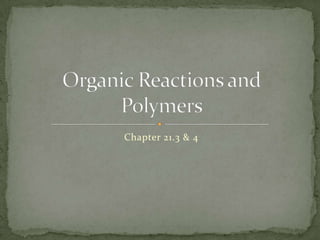
Chapter 21.3 : Organic Reactions and Polymers
- 1. Chapter 21.3 & 4 Organic Reactions and Polymers
- 2. Describe and distinguish between the organic reactions: substitution, addition, condensation, and elimination Relate some functional groups to some characteristic reactions Identify the two main types of polymers and the basic reaction mechanisms by which they are made Objectives:
- 3. Substitutions Reaction Reaction in which one or more atoms replace another atom or group of atoms in a molecule example: reaction between a methane (an alkane) and chlorine (a halogen) to form an alkyl halide Chloroform/CFC’s created in this way. Trichloromethane / tetrachloromethane
- 4. Addition Reactions Reaction in which two parts of a molecule are added to an unsaturated molecule, increasing the saturation of the molecule example: hydrogenation, the addition of hydrogen atoms to an unsaturated molecule Vegetable oils contain long chains of carbon atoms with many double bonds Unsaturated fats Saturated fats
- 5. Hydrogenation of Fatty Acid
- 6. Condensation Reaction Reaction in which two molecules or parts of the same molecule combine A small molecule, such as water, is usually removed during the reaction example: a reaction between two amino acids (which contain both amine and carboxyl groups) When repeated many times, this reaction forms a protein molecule: a chain of amino acids
- 7. Elimination Reaction Reaction in which a simple molecule, such as water or ammonia, is formed from adjacent carbon atoms of a larger molecule example: the heating of ethanol in the presence of concentrated sulfuric acid
- 8. Polymers large molecules made of many small units joined to each other through organic reactions Monomers The small units A polymer can be made from identical or different monomers Copolymer A polymer made from two or more different monomers Polymers are all around us Natural polymers: starch, cellulose, proteins Synthetic polymers: plastics, synthetic polymers (e.g. polypropylene)
- 9. Addition polymers polymer formed by addition reactions between monomers that contain a double bond example: molecules of ethene can polymerize with each other to form polyethene, commonly known as polyethylene The letter n shows that the addition reaction can be repeated multiple times to form a polymer n monomers long This reaction can be repeated hundreds or thousands of times
- 10. Addition Polymers Vulcanization : cross-linking process between adjacent polyisoprene molecules that occurs when the molecules are heated with sulfur atoms.
- 11. Forms of polyethylene Branches keep LPDE from packing tightly Cross-links make CPE very strong Linear HDPE can pack together closely
- 12. Condensation Polymers Polymer formed by condensation reactions Monomers of condensation polymers must contain two functional groups: this allows each monomer to link with two other monomers by condensation reactions Condensation polymers are usually copolymers with two monomers in an alternating order
- 13. Polyester Another condensation polymer Polyethylene terephthalate (PET) Ethylene glycol and terephtalic acid Alcohol and carboxylic acid As usual, water is the other product